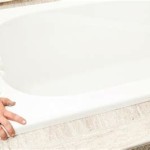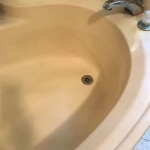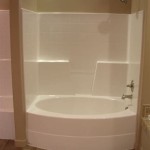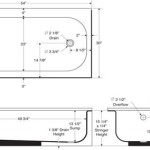```html
How to Remove a Moen Bathtub Plug
Removing a Moen bathtub plug can seem like a daunting task, but with the right knowledge and tools, it is a manageable DIY project. Blocked or malfunctioning bathtub plugs hinder proper drainage, leading to unsanitary conditions and potential water damage. Understanding the different types of Moen bathtub plugs and the corresponding removal methods is crucial for successful completion of the task.
Moen, a well-known manufacturer of plumbing fixtures, utilizes various plug designs in its bathtubs. Some plugs are simple lift-and-turn mechanisms, while others are more complex pop-up or toe-touch drain assemblies. Identifying the specific type of plug present is the first step towards effective removal. Improperly attempting to remove a plug can cause damage to the drain assembly or the bathtub finish, so caution and patience are paramount.
Identifying the Type of Moen Bathtub Plug
Before attempting any removal process, it's essential to correctly identify the type of Moen bathtub plug in question. Common types include the lift-and-turn drain, the pop-up drain, and the toe-touch drain. Each type operates differently and requires a specific approach for removal.
The lift-and-turn drain typically features a small knob or lever on top of the drain stopper. To close the drain, the knob is lifted and then turned. This action engages a mechanism that lowers the stopper into the drain opening. To open the drain, the knob is lifted and turned in the opposite direction, disengaging the mechanism and raising the stopper. The removal process for this type of drain primarily involves unscrewing or loosening the knob or lever.
The pop-up drain features a stopper that is raised and lowered by a lever located on the overflow plate, typically situated near the faucet. When the lever is moved, it pulls or pushes a connecting rod that in turn raises or lowers the stopper in the drain. Removal of this type of drain usually involves accessing the connecting rod behind the overflow plate.
The toe-touch drain operates with a simple push of the drain stopper. Pressing the stopper with a toe activates a spring-loaded mechanism that either seals or unseals the drain opening. Successive presses alternate between the open and closed positions. Removal of this drain commonly involves unscrewing the stopper itself or accessing the assembly from beneath the tub, depending on the specific model.
Tools and Materials Required
Having the appropriate tools and materials on hand will significantly facilitate the removal process and minimize the risk of damage. Essential tools typically include a screwdriver set (both Phillips and flathead), pliers, a drain wrench (also known as a dumbbell wrench), and potentially a basin wrench for accessing hard-to-reach areas. A flashlight is useful for illuminating the drain area, and a pair of gloves will protect hands from dirt and grime. A small container or bag is helpful for storing small parts, preventing them from being lost.
In addition to tools, specific materials may be necessary depending on the complexity of the removal. For example, penetrating oil can help loosen corroded or stuck parts. Plumber’s putty or silicone sealant might be required for resealing the drain after reassembly. Clean rags or paper towels are essential for wiping away dirt and water. Having these materials readily available will streamline the process and ensure a professional outcome.
Selecting the correct screwdriver size is critical to avoid stripping the screw heads. Similarly, using the appropriate wrench size will prevent damage to the drain components. Taking the time to gather the necessary tools and materials beforehand will save time and frustration in the long run.
Step-by-Step Removal Procedures for Different Plug Types
The specific steps involved in removing a Moen bathtub plug vary depending on the type of drain assembly. The following sections outline the general procedures for removing the three most common types: lift-and-turn, pop-up, and toe-touch drains.
Lift-and-Turn Drain: This type of drain typically has a screw located on top of the knob. Start by using a screwdriver to loosen and remove this screw. Once the screw is removed, the knob or lever should be able to be lifted off. Beneath the knob, there may be a stem or post that is attached to the drain stopper. This stem is often threaded or simply held in place by friction. If threaded, carefully unscrew the stem. If friction-fit, gently pull the stem upwards. Once the stem is removed, the drain stopper should be free. It can then be lifted out of the drain. If the stopper is stuck, gently wiggle it back and forth while pulling upwards. Avoid using excessive force, as this could damage the drain or the stopper.
Pop-Up Drain: The initial step in removing a pop-up drain involves removing the overflow plate located near the tub's faucet. Unscrew the screws holding the overflow plate in place. Once the screws are removed, gently pull the overflow plate away from the tub wall. Behind the overflow plate, there will be a connecting rod. This rod connects the lever on the overflow plate to the drain stopper. There is usually a clevis or clip that connects the rod to the stopper mechanism. Disconnect this clevis or clip. Once the connecting rod is disconnected, the drain stopper should be free to be removed. To remove the stopper, reach into the drain opening and pull it straight up. If the stopper is stuck, try wiggling it gently while pulling. In some cases, the stopper may have a threaded connection at the bottom. If so, unscrew the stopper before attempting to remove it.
Toe-Touch Drain: Removing a toe-touch drain typically involves unscrewing the drain stopper itself. The stopper usually has a fluted or textured surface to provide grip. In some cases, the stopper may be designed to be unscrewed by hand. If this is the case, simply grip the stopper firmly and turn it counterclockwise. If the stopper is difficult to grip, use a rubber glove or a piece of cloth to improve traction. If the stopper is tightly secured, a specialized drain wrench or a pair of pliers may be necessary. Wrap the pliers with tape to protect the finish of the stopper. Gently grip the stopper with the pliers and turn it counterclockwise. Once the stopper is unscrewed, it can be lifted out of the drain. Some toe-touch drains have a more complex assembly that requires access from beneath the tub. In these cases, it may be necessary to remove an access panel or to access the drain from the floor below. If accessing from below is necessary, ensure that the water supply is shut off before proceeding.
Dealing with Stubborn or Corroded Plugs
Sometimes, bathtub plugs become stuck due to corrosion, mineral buildup, or debris accumulation. In such cases, applying penetrating oil can help loosen the plug. Spray the penetrating oil around the base of the plug and allow it to soak for several hours or even overnight. This allows the oil to seep into the threads and loosen any corrosion or buildup.
Another method for loosening a stubborn plug is to use gentle heat. A hairdryer can be used to warm the plug and the surrounding drain area. The heat will help to expand the metal slightly, which can break the bond of corrosion. Be careful not to overheat the area, as this could damage the tub finish. After applying heat, try wiggling the plug gently and applying pressure to remove it.
If penetrating oil and heat are not sufficient, a specialized drain wrench may be necessary. A drain wrench, also known as a dumbbell wrench, is designed to grip the inside of the drain and provide leverage for turning. Insert the drain wrench into the drain opening and adjust it to fit snugly against the inside walls. Then, apply steady pressure and turn the wrench counterclockwise to loosen the plug. If the plug is extremely stubborn, it may be necessary to use a cheater bar to increase leverage. However, exercise caution to avoid damaging the drain or the bathtub.
In extreme cases, where all other methods have failed, it may be necessary to call a professional plumber. A plumber has specialized tools and expertise to remove stubborn plugs without causing damage to the plumbing or the bathtub. Attempting to force a severely corroded plug can result in broken pipes or damage to the drain assembly, which can be more costly to repair than simply hiring a professional.
Cleaning and Inspecting the Drain
Once the plug has been successfully removed, it is essential to thoroughly clean and inspect the drain. Over time, hair, soap scum, and other debris can accumulate in the drain, causing clogs and slow drainage. Cleaning the drain will help to prevent future problems and ensure that the bathtub drains properly.
Start by removing any visible debris from the drain opening. A pair of tweezers or needle-nose pliers can be helpful for removing large clumps of hair or other obstructions. Next, use a drain snake or auger to clear any blockages further down the drainpipe. Insert the snake into the drain opening and rotate it as you push it down. The snake will help to break up and remove any debris that is blocking the drain.
After snaking the drain, flush it with hot water. The hot water will help to dissolve any remaining soap scum or grease. You can also add a drain cleaner to the hot water to further clean the drain. Be sure to follow the instructions on the drain cleaner carefully and avoid using harsh chemicals that could damage the pipes.
Once the drain is clean, inspect it for any signs of damage or corrosion. Check the drainpipe for leaks or cracks. If you find any damage, it is important to repair it promptly to prevent water damage. If you are not comfortable making the repairs yourself, it is best to call a professional plumber.
Reassembling the Drain
After the drain has been thoroughly cleaned and inspected, it is time to reassemble the drain. The reassembly process will vary depending on the type of drain assembly, but the general steps are the same.
Start by replacing any parts that were removed during the disassembly process. This may include the drain stopper, the connecting rod, the overflow plate, and any screws or other fasteners. Be sure to use the correct screws and fasteners for each part to ensure that the drain is properly assembled.
When reassembling the drain, it is important to ensure that all of the connections are tight and secure. Loose connections can cause leaks and other problems. Use a wrench or screwdriver to tighten all of the screws and fasteners. Be careful not to overtighten the connections, as this could damage the parts.
After the drain has been reassembled, test it to make sure that it is working properly. Fill the bathtub with water and then open the drain. Check for leaks around the drain opening and the overflow plate. If you find any leaks, tighten the connections or replace any damaged parts.
```
How To Remove Moen Popup Bathtub Drain Stopper

How Remove Moen Tub Stopper And Unclog Drain

How To Remove Moen Popup Bathtub Drain Stopper

How To Remove A Bathtub Drain Stopper

Bathroom Repair How To A Pop Up Tub Drain Stopper

How To Remove A Bathtub Drain Stopper

How To Remove A Moen Bathtub Drain Stopper Hunker

How To Remove Moen Bathtub Shower Drain Stopper Plug Clean Out Hair Clogged Pipe Diy Guide

How To Remove A Bathtub Drain Stopper

How To Remove Moen Popup Bathtub Drain Stopper
Related Posts







